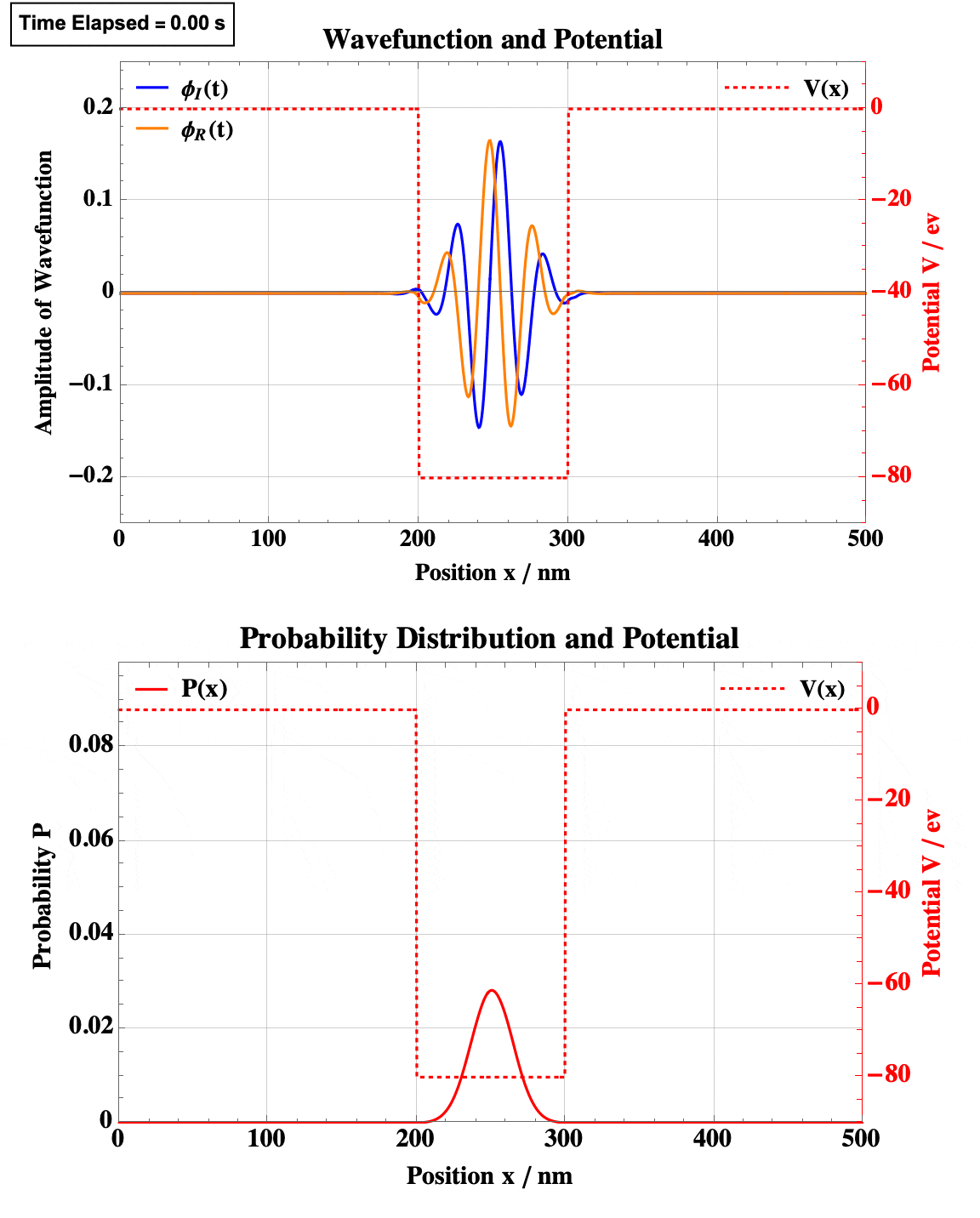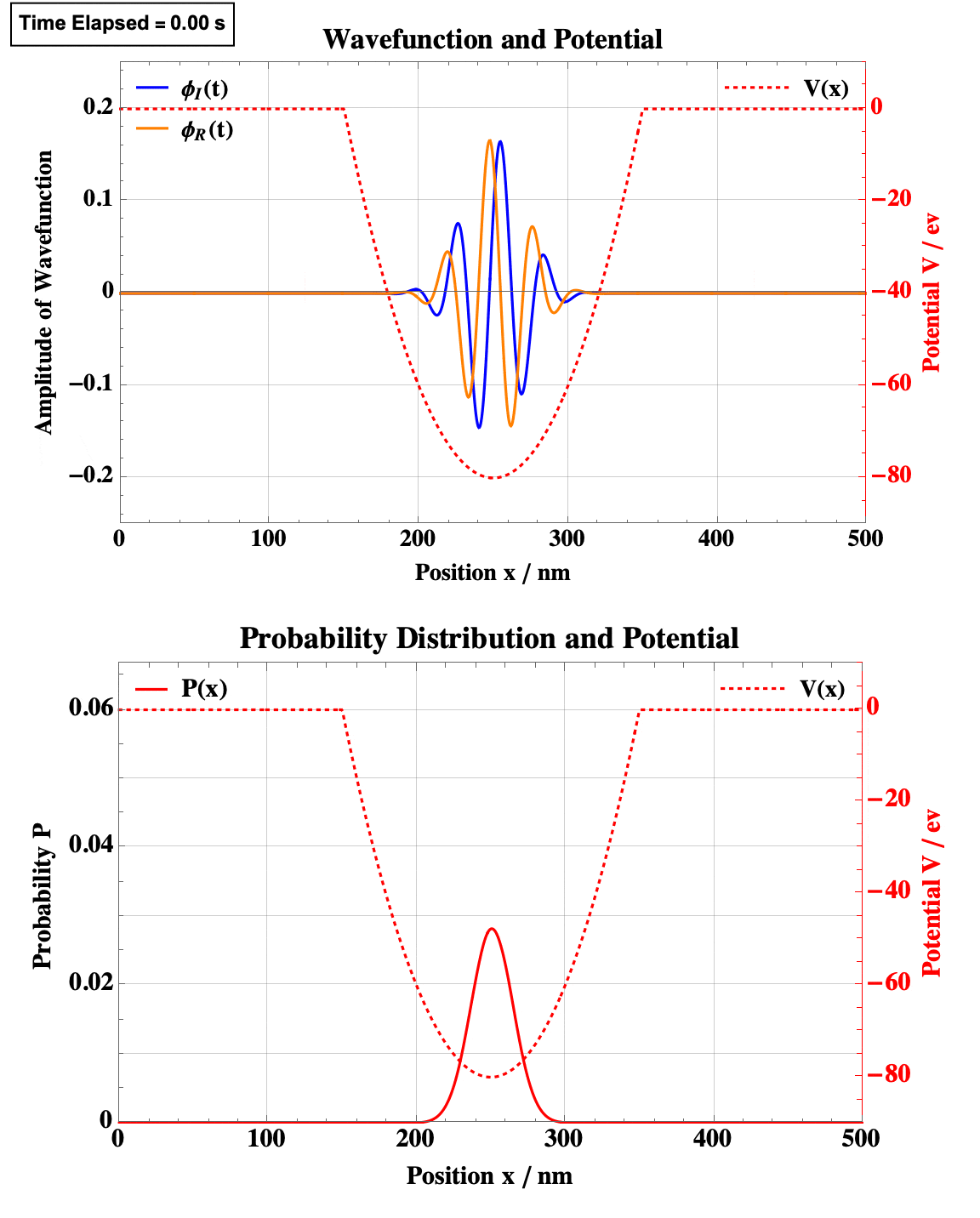Solving the Time-Dependent-Schroedinger Equation

Solving the Time-Dependent-Schroedinger Equation
Evolution of a particle in different potentials: free, step, square, harmonic
This research project was part of my MSc Physics at Imperial College London in 2021 - one week project.
As part of my studies at Imperial I embarked on a 1 week project. I chose to play around with the centerpiece of quantum mechanics - the Time-Dependent Schroedinger Equation (TDSE):
$$i \hbar \frac{\partial}{\partial t} \Psi(\mathbf{r},t) = H \Psi(\mathbf{r},t)$$
Motivation
The aim of the 1 week project was to build something cool with Mathematica. Having dealt with the time-independent version of the Schroedinger Equation in countless problem sheets and exams, problems and exercises with the time-dependent version always seemed very distant. I wanted to gain intuition via a nice animation.
This was the goal: Gain intuition of the TDSE in the standard potential wells.
Project Summary
In this project the time-dependent Schroedinger Equation has been solved using the 'Finite Domain Time Difference Method' for different simple static potential wells for a Gaussian wave packet.
The behavior of the particle waves exhibits the inherently quantum mechanical behavior that is expected. The animations generated allow to gain physical intuition.
Theory
The equation to solve is the time-dependent Schroedinger Equation (TDSE):
$$i \hbar \frac{\partial \Psi(x,t)}{\partial t} = H(x) \Psi(x,t)$$
with H(x) the static Hamiltonian. For simplicity here a static potential was chosen.
$$H(x) = -\frac{\hbar^2}{2m} \frac{\partial^2}{\partial x^2} + V(x)$$
The TDSE can be rewritten applying the standard "Finite Time Difference Method" (see here):
$$\frac{\partial \Psi(x,t)}{\partial t} = \frac{\Psi(x, t + \Delta t) - \Psi(x,t)}{\Delta t}$$
$$\frac{\partial^2 \Psi(x,t)}{\partial x^2} = \frac{\Psi(x, t + \Delta t) - 2 \Psi(x,t) + \Psi(x-\Delta x,t)}{\Delta x^2}$$
Substituting this into the TDSE yields:
$$\Psi(x, t+\Delta t) = \Psi(x,t) - \frac{\Delta t \hbar}{2 i (\Delta x)^2 m} \Bigg[ \Psi(x+\Delta x,t) -2 \Psi(x,t) + \Psi(x-\Delta x, t)\Bigg] + \frac{\Delta t}{i \hbar} V(x) \Psi(x,t)$$
where we define the constants as
$$c_1 = \frac{\Delta t}{2 (\Delta x)^2 m}$$
and
$$c_2 = \frac{\Delta t}{\hbar}$$
Then taking the real and imaginary parts of the wavefunction one finally arrives at the equations used for the calculation:
$$\Phi_R(x,t+\Delta t) = \Phi_R(x,t) - c_1 \Bigg[\Phi_I(x+\Delta x, t)+ 2 \Phi_I(x,t) +\Phi_I(x-\Delta x, t) \Bigg] +c_2 V(x) \Phi_I(x,t)$$
$$\Phi_I(x,t+\Delta t) = \Phi_I(x,t) + c_1 \Bigg[\Phi_R(x+\Delta x, t)+ 2 \Phi_R(x,t) +\Phi_R(x-\Delta x, t) \Bigg] +c_2 V(x) \Phi_R(x,t)$$
These two equations are the core of the simulation. For the purpose of generating a meaningful animation the constants c₁ and c₂ have been slightly adapted.
The wavefunction defining the particle to simulate is chosen to be a well defined electron. In order to define the particle well, a Gaussian wave packet is chosen. For a Gaussian wavepacket a single wavevector can be defined as its Fourier transform frequencies are clustered around that single wave vector. This allows to define a somewhat localized particle. The Gaussian wavepacket is:
$$\Psi(x, 0) = \Phi_0(x) = \frac{1}{\sqrt{\sigma \sqrt{\pi}}} e^{- \frac{x^2}{2*\sigma^2}}$$
Let us define the normalization as: $$\sqrt{\sigma \sqrt{\pi}} = A$$
Then the modulated real and imaginary parts are:
$$\Phi_R(x,0) = \frac{1}{A} e^{-\frac{1}{2} \big( \frac{x-x_0}{s} \big)^2} cos[k (x-x_0)]$$
$$\Phi_I(x,0) = \frac{1}{A} e^{-\frac{1}{2} \big( \frac{x-x_0}{s} \big)^2} sin[k (x-x_0)]$$
Where the normalization constant can be found by integration according to the Born Rule:
$$1 = \int_{-\infty}^{\infty} |\Psi(x,t)|^2 ,dx$$
The particle's momentum is specified using the deBroglie relations:
$$p = \hbar k$$
Where k is the wavevector defined as:
$$k = \frac{2 \pi}{\lambda}$$
The potentials chosen to present here are all finite potentials:
- Finite square well
- Finite step well
- Quadratic/harmonic
The default particle presented has a wavelength $$\lambda = 30 nm$$ and a rest mass m = m₁. Therefore the energy of the chosen electron particle has a kinetic energy as a free particle given by the deBroglie relation as:
$$E = \hbar \omega = \frac{h c}{\lambda} \approx 6.625*10^{-18} J \approx 41.35 eV$$
Therefore to explore the interesting behavior of a bound particle we choose the well depth or well height to be 80eV.
Aims & Objectives
Aims
- Solve the time dependent Schroedinger equation using the 'Finite Domain Time Difference Method'
- Demonstrate the working method on a few potentials
- Comment on physical intuition gained
Objectives
- Discretize space and time
- Implement physical potential parameters
- Implement physical particle/wave parameters
- Generate potential wells: free, square, harmonic, step
- Demonstrate potential wells
Results
See Sum-up video here:
The individual simulations are also shown here:
Free Particle

Finite Square Well

Quadratic Well

Step Well

Note the obvious quantum tunneling here.
Code
The complete theory and workings in Mathematica are documented on my GitHub: gordonkoehn/tdse
